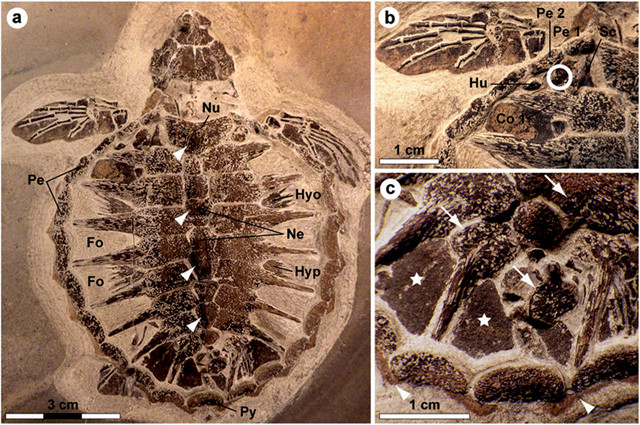
by Mary Caperton Morton Friday, January 12, 2018

Preserved biomolecules were found in this specimen of an Eocene sea turtle, Tasbacka danica, which was found in Denmark. The circle in (b) indicates the part of the turtle's carapace — enlarged in (c) — sampled by researchers. Credit: Lindgren et al., Scientific Reports, October 2017, CC BY 4.0.
A study of a 54-million-year-old sea turtle hatchling found in Denmark is adding to a growing body of evidence that certain proteins can remain intact in the fossil record for tens of millions of years.
In 2008, an unusually well-preserved Tasbacka danica hatchling, about 7.4 centimeters long, was recovered from the Für Formation on Denmark’s Isle of Mors, which has produced a plethora of marine fossils, including fish, reptiles and birds dating to the Early Eocene. In the new study, published in Scientific Reports, a team led by Johan Lindgren of Lund University in Sweden extracted biomolecular samples from the turtle’s left shoulder region. The researchers confirmed the material was original tissue using a combination of high-resolution analytical techniques such as scanning electron microscopy and infrared microspectroscopy.
Modern sea turtle hatchlings have very low survival rates, with as many as 99 percent dying before they mature, mostly through predation on land or in the water. The preserved molecules included pigments that indicate that Eocene turtles had already evolved dark shells that likely helped camouflage them amid the water’s dark surface when seen from above.
“The data not only support the preservation of multiple proteins, but also suggest that coloration was used for physiology as far back as the Eocene, in the same manner as it is today,” said co-author Mary Schweitzer of North Carolina State University in a statement.
© 2008-2021. All rights reserved. Any copying, redistribution or retransmission of any of the contents of this service without the expressed written permission of the American Geosciences Institute is expressly prohibited. Click here for all copyright requests.